New trends in multi-axis motion designs abound. Consider the rise of metrology reports to accompany designs — which serve as “birth certificates” in the form of well-informed simulation models and Excel spreadsheets that quantify the accuracy and capabilities of pre-engineered builds. In some cases, such reports give OEMs and end users accurate data on how the stages and other motion designs will perform — and sometimes even how the design will respond to changes.
As Matt Price, technical manager — micropositioning applications at Physik Instrumente (PI) explains, “As a provider of motion gantries, XY tables and sub-assemblies, we think there’s great value in preconfigured motion subsystems calibrated and tuned in the structures in which they are integrated and assembled. This is a critical part of motion control — and a core competency of our systems groups. With a complete (built and characterized) gantry or assembly, you can be assured of performance of the motion system as a whole and avoid many issues that can arise from not proper considering their combined performance.”
Other trends that have continued unabated are the move to stages, Cartesian robots, and indexing tables (with turnkey operation for very specific applications) as well as the outsourcing by OEMs and plant engineers of table and stage design to high-tech distributors and motion suppliers. Following are additional details on these trends from several industry experts.

New Aerotech automation hardware features an industrial (noise-immune) fiber-optic drive-to-drive communication network.
One major trend is that of new processes for outsourcing the design of motion subassemblies.
RJ Hardt | Business development manager • Aerotech: Outsourcing motion subassemblies has become a hot topic as markets become saturated and more competitive. Outsourcing lets companies put more effort into their core competencies while offloading parts of their offering to partners to add value. The process of outsourcing starts with a consultative supplier that works with you to determine your needs before proposing a solution. Afterwards, engineering and technical resources must be delivered, and then the vendor’s manufacturing resources need to be aligned with your market. In fact, we’ve deployed a direct-consultative field sales staff that walks customers through well-defined design engineering and manufacturing processes to help them capture targeted market opportunities.
William Land | Business development manager • Aerotech: We’ve always aimed to offer more value through higher levels of system integration. Case in point: By adding localized memory on certain mechanical offerings, we can store mechanical product-specific setup parameters and user settings on each device. This allows dynamic interoperability between electrical and mechanical component categories, because the mechanical products now carry with them the relevant information to successfully connect to and operate them.
When a user plugs in a new controller and drive to a supported mechanical product, they are encouraged to download controller settings off of the mechanical product through prompting, ensuring that the combined solution functions appropriately. The original parameter data is installed at the factory and carried with the mechanical product.
This is just one step on the path to having electrical and mechanical products dynamically and seamlessly recognize each other’s product type and configuration and then adjust their operating parameters accordingly.

Aerotech QFOCUS piezo positioners for microscopes offer travels to 450 µm and 0.15-nm resolution.
Richard Halstead | President • Empire Magnetics: My viewpoint may be biased due to the customer base we serve — including aerospace and military, JPL, NASA, and labs at major universities. With that caveat, we can see the following trends.
1. The most experienced baby-boomer engineers are retiring, and there aren’t enough trained people to replace them. Add to this the fact that the bulk of today’s newer engineers have great computer skills but not a lot of practical experience with mechanics. They can produce designs with 3D models and execute similar tasks, but unless the company they work for has the machine shops and machine operators to actually make the parts, these engineers are looking at a long supply chain. If they go down this path, they have the responsibility of making the system work.
The alternative is to subcontract the whole mechanical package so there is a party to be held responsible for the unit performance.
2. We also see that China in particular has overbuilt production capacity. That means they offer prices that make it difficult to justify the use of alternatives. Management analysis easily determines that moving up the value chain is much better use of engineering resources … assuming that quality can be maintained working with a subcontracting source from Asia.
Other motion suppliers that serve the semiconductor market help on machine builds that must operate in vacuum environments.
Hardt • Aerotech: We supply motion control equipment to many of the semiconductor industry’s leading process-management OEM machine builders. With these machines, there’s increasing need to characterize and measure incredibly small defects — because semiconductor node- manufacturing techniques are trending towards sub-10-nanometer feature sizes. We’ve enabled leading-edge optical inspection processes with sub-nanometer positioning stages. Electron-beam inspection is becoming necessary at these smaller node sizes. The challenge is that this process must occur in vacuum … so now we manufacture and sell ultra-high-vacuum wafer-positioning stages to serve this application.
In fact, the most involved customization is for designs to serve the consumer electronics and life-science industries. Often, these take the form of one-off machine builds with precision specifications.
Price • Physik Instrumente (PI): On the hardware side, PI provides customized stage, stage assemblies, and motion systems to address specific application and system-integration requirements. This includes motion subassemblies with integrated structures and cable management systems configured for streamlined system integration. On the software side, PI provides application-specific commercial and open-source software that can be used for complete system control … including key areas of expertise such as photonic-alignment systems, laser materials processing, and 3D printing. On the service side, we provide onsite installation, training, and service contracts.

This value-added gantry from Physik Instrumente (PI) integrates six-axis hexapod motion platforms for alignment and testing of silicon photonics components.
Yet another industry change is that towards more value-add services and in-house engineering support from motion-component suppliers for OEMs.
Brian O’Connor | Director of product and market development • Aerotech: We’re known for customizing motion solutions to specific applications and customers. We realize that one size never fits all … and rarely fits most. Our customers are in all markets and business types (as OEMs, integrators, and end users) needing custom engineering and design as well as onsite metrology and proof-of-concept testing. Our applied technologies engineers and control system specialists routinely visit OEMs, integrators, and end users to help them get the most out of their motion subsystems. This includes onsite system setup and optimization … as well as custom software-algorithm development and implementation.
Matt Mowry | North American market manager for Drylin products • igus: Mechanical designers want to focus on solving their end-user problems with their own technology — and would rather buy a customized or even standard product from motion suppliers that specialize in linear bearing systems. Sourcing this way makes shortens the design time … and in the end, it also reduces the costs compared to them designing and manufacturing components or subassemblies.
Software tools continue to change how design engineering is done — even for Cartesian robots, tables, and other integrated motion designs. New tools abound … for example, Bosch Rexroth’s EasyHandling digital catalog details predesigned Cartesian systems with features for foolproof installation.
Price • Physik Instrumente (PI): We provide a product selector on our website to support selections based on key motion specifications — and allow for quick identification of best options from a broad portfolio of products. In addition, STEP files are available for most standard products. These two things are helping accelerate design engineering and the identification of best solutions with PI engineers.
Brian Fink | Product manager • Aerotech: Aerotech offers system-sizing software to clients and prospective users. Our Motor Sizer helps our sales and applications engineering team effectively work with clients to select the most appropriate combination of mechanics and control electronics for the intended application.
Through defining the desired motion profiles and computing the payload mass and inertia, the Motor Sizer utility automatically calculates the required force or torque, motor currents, and bus voltages to execute the prescribed trajectories — and it even estimates the final motor temperature. Such outputs facilitate the evaluation and comparison of alternate motion-system solutions, and lets users optimize their motion trajectories to maximize system throughput (within the limitations of the positioning mechanics and control electronics). Engineers can download the Motor Sizer utility for free at www.aerotech.com.
Patrick Wheeler | Product manager • Aerotech: We offer a variety of software tools that let users engineer complete machine-control schemes — including commanding motion … prior to ever connecting to a motor drive, motor, or I/O. Such simulation environments let users see the acceleration profiles of their motion commands. This information is exportable and can be post-processed to let engineers assess what type of motors will be needed to execute the required moves … for easier system specification.
Interoperability between motion components is also a major trend.
Wheeler • Aerotech: We ensure interoperability by supplying a single-controller solution that can control servomotors, galvanometer scan-head motors, hexapods, voice coils, and piezoelectric actuators. In other words, the same controller is used … no matter what time of mechanical device the system is controlling. This lets OEM and integration companies diversify product offerings without undue burden on internal training and development.
Price • Physik Instrumente (PI): We develop and deliver factory-configuration files for stages and actuators with optimized parameter sets … to allow instant operation with PI and ACS control solutions. This work is done at the component level to guarantee immediate operation and completely defined and defined motion performance.
In addition, our motion assemblies and custom systems include stages configured for the control solution under application-specific operating parameters. We collaborate with the customer and provide metrology reports to confirm the design. Our stages also include features for compatibility with industrial standards that make them readily compatible with PI and ACS controls (to be interfaced with such standards).
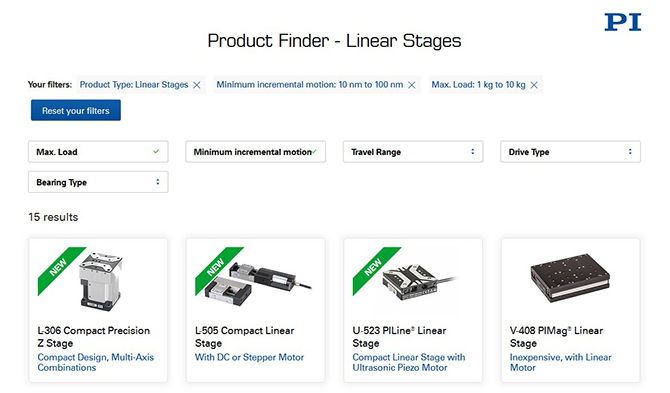
The Physik Instrumente (PI) product finder facilitates product selection. Engineers enter parameters such as bearing type, drive type, load, and resolution to get recommendations.
Filed Under: Linear Motion Tips, Robotics • robotic grippers • end effectors

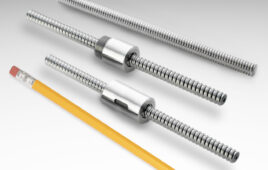
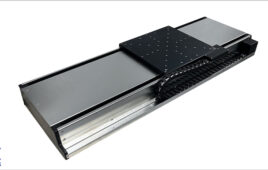
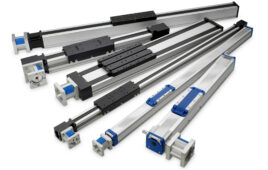
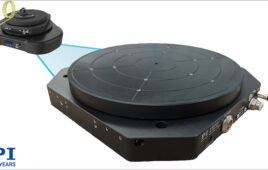
Tell Us What You Think!